Unit 1 Past and Present Grammar课件 牛津译林版八年级下册
文档属性
| 名称 | Unit 1 Past and Present Grammar课件 牛津译林版八年级下册 |  | |
| 格式 | pptx | ||
| 文件大小 | 7.3MB | ||
| 资源类型 | 试卷 | ||
| 版本资源 | 牛津译林版 | ||
| 科目 | 英语 | ||
| 更新时间 | 2025-02-11 10:06:54 | ||
图片预览

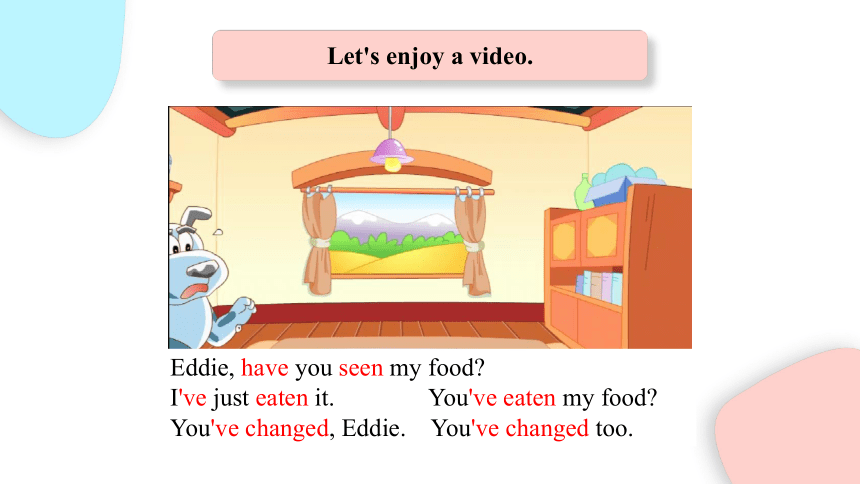
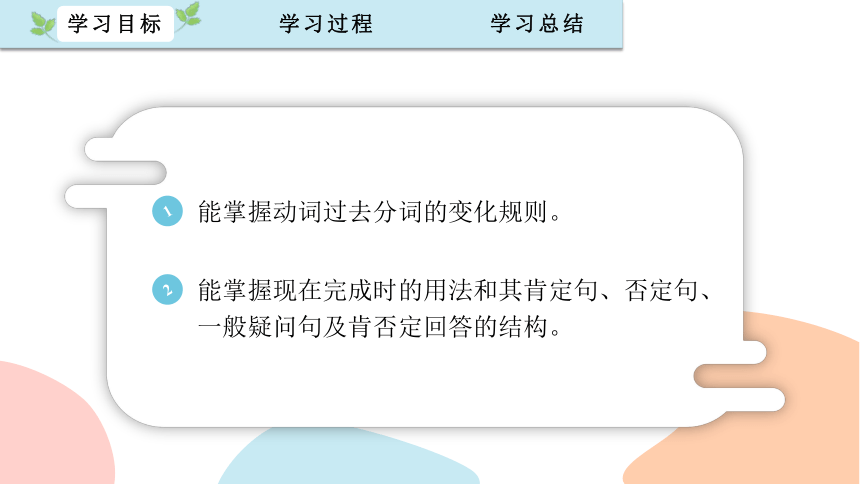
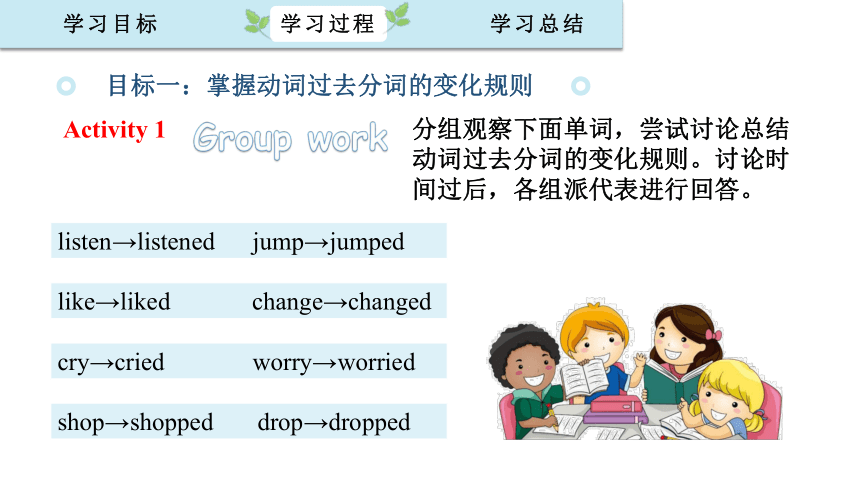
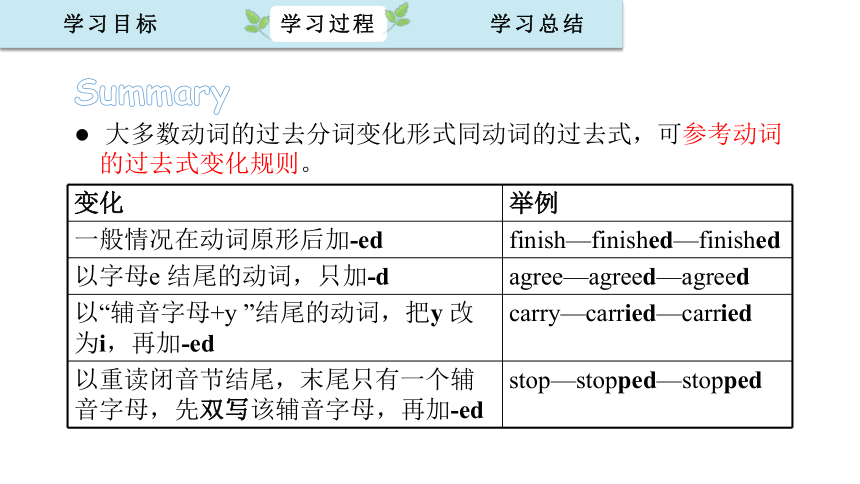
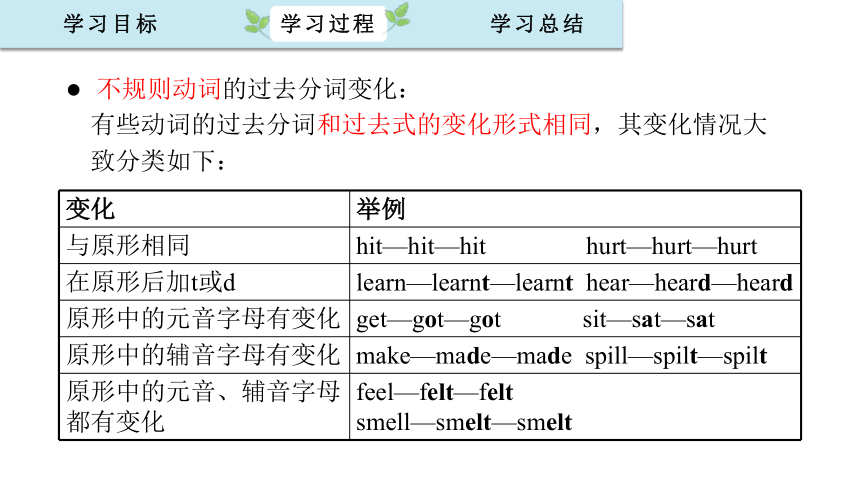
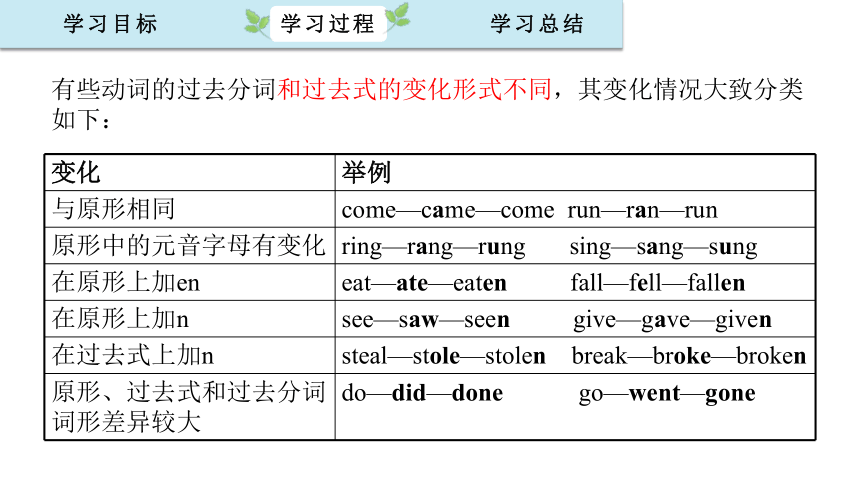
文档简介
(共14张PPT)
Unit 1
Past and present
Period 3 Grammar
Let's enjoy a video.
Eddie, have you seen my food
I've just eaten it. You've eaten my food
You've changed, Eddie. You've changed too.
1
2
能掌握现在完成时的用法和其肯定句、否定句、一般疑问句及肯否定回答的结构。
能掌握动词过去分词的变化规则。
Activity 1
Group work
分组观察下面单词,尝试讨论总结动词过去分词的变化规则。讨论时间过后,各组派代表进行回答。
目标一:掌握动词过去分词的变化规则
listen→listened jump→jumped
like→liked change→changed
cry→cried worry→worried
shop→shopped drop→dropped
Summary
● 大多数动词的过去分词变化形式同动词的过去式,可参考动词
的过去式变化规则。
变化 举例
一般情况在动词原形后加-ed finish—finished—finished
以字母e 结尾的动词,只加-d agree—agreed—agreed
以“辅音字母+y ”结尾的动词,把y 改为i,再加-ed carry—carried—carried
以重读闭音节结尾,末尾只有一个辅音字母,先双写该辅音字母,再加-ed stop—stopped—stopped
● 不规则动词的过去分词变化:
有些动词的过去分词和过去式的变化形式相同,其变化情况大
致分类如下:
变化 举例
与原形相同 hit—hit—hit hurt—hurt—hurt
在原形后加t或d learn—learnt—learnt hear—heard—heard
原形中的元音字母有变化 get—got—got sit—sat—sat
原形中的辅音字母有变化 make—made—made spill—spilt—spilt
原形中的元音、辅音字母都有变化 feel—felt—felt smell—smelt—smelt
有些动词的过去分词和过去式的变化形式不同,其变化情况大致分类如下:
变化 举例
与原形相同 come—came—come run—ran—run
原形中的元音字母有变化 ring—rang—rung sing—sang—sung
在原形上加en eat—ate—eaten fall—fell—fallen
在原形上加n see—saw—seen give—gave—given
在过去式上加n steal—stole—stolen break—broke—broken
原形、过去式和过去分词词形差异较大 do—did—done go—went—gone
下表展示了动词过去分词的更多例子。
Regular verbs Irregular verbs Base form Past participle Base form Past participle
visit visited send sent
repair repaired put put
live lived meet met
move moved make made
try tried sell sold
study studied say said
fit fitted write written
plan planned think thought
Tip:
五级以内不规则动词的过去式及过去分词变化表,详见教材第122-123页。
Activity 2
Exercise
Mr Wu wants the students to practise using the present perfect tense. Help them write the past participles of the verbs below.
1 borrow _______
2 hope ______
3 make ______
4 get ______
9 say ______
10 grow ______
11 hit ______
12 enjoy ______
5 plan _______
6 cry _______
7 send _______
8 watch _______
borrowed
hoped
made
got
planned
cried
sent
watched
said
grown
hit
enjoyed
目标二:掌握现在完成时的用法和其肯定句、否定句、
一般疑问句及肯否定回答的结构
Activity 1
Group work
分组观察下面的句子,尝试讨论总结现在完成时的用法及各种句式结构,讨论时间过后,小组派代表进行回答。
I/You/We/They have arrived.
He/She/It has I/You/We/They have not arrived.
He/She/It has Have I/you/we/they arrived
Has he/she/it Yes, I/you/we/they have.
he/she/it has.
No, I/you/we/they haven't.
he/she/it hasn't.
I have lived here since I was born.
Eddie has just eaten Hobo's food.
I have already read this book many times.
Summary
用法:
● 我们用现在完成时来谈论一个从过去开始一直持续到现在的动作。
● 我们用现在完成时来谈论一个发生在过去且与现在有联系的动作
● 我们也用现在完成时态来谈论一个动作到现在已经发生了多少次。
结构:
● 肯定句:主语 + have / has + 动词过去分词 (+ 其他).
● 否定句:主语 + have / has + not + 动词过去分词 (+ 其他).
● 一般疑问句及其肯定否定回答:
Have / Has + 主语 + 动词过去分词 (+ 其他)
Yes, 主语 + have / has. No, 主语 + haven't / hasn't.
Activity 2
Exercise
Mr Wu asks the students to complete the sentences below using the present perfect tense. Help them complete the sentences.
1. They _____________ (finish) their homework already.
2. John ________ never _________ (visit) China.
3. Mr Li ____________ (repair) over ten bicycles since Monday.
4. We ____________ (not see) each other for years.
5. My parents _____________ (not come) back yet.
6. Our teacher __________ (teach) us a lot about the history of China.
have finished
has visited
has repaired
haven't seen
haven't come
has taught
Millie and Sandy are talking about a film about the history of plete their conversation with the correct forms of the verbs in brackets.
Millie: ______ you _____ (see) any films recently, Sandy
Sandy: No, I haven't. What about you
Millie: I _____ (see) one last Saturday.
Sandy: What's it about
Millie: It's about the changes in Beijing over the past century. From this
film, I __________ (learn) more about Beijing's past and present.
Sandy: Oh, I think I __________ (hear) about the film. Do you plan to
see it again
Millie: Yes, I'd like to.
Have seen
saw
have learnt
have heard
综合上述目标,说说我们今天的收获。
学习目标
1
2
能掌握现在完成时的用法和其肯定句、否定句、一般疑问句及肯否定回答的结构。
能掌握动词过去分词的变化规则。
Unit 1
Past and present
Period 3 Grammar
Let's enjoy a video.
Eddie, have you seen my food
I've just eaten it. You've eaten my food
You've changed, Eddie. You've changed too.
1
2
能掌握现在完成时的用法和其肯定句、否定句、一般疑问句及肯否定回答的结构。
能掌握动词过去分词的变化规则。
Activity 1
Group work
分组观察下面单词,尝试讨论总结动词过去分词的变化规则。讨论时间过后,各组派代表进行回答。
目标一:掌握动词过去分词的变化规则
listen→listened jump→jumped
like→liked change→changed
cry→cried worry→worried
shop→shopped drop→dropped
Summary
● 大多数动词的过去分词变化形式同动词的过去式,可参考动词
的过去式变化规则。
变化 举例
一般情况在动词原形后加-ed finish—finished—finished
以字母e 结尾的动词,只加-d agree—agreed—agreed
以“辅音字母+y ”结尾的动词,把y 改为i,再加-ed carry—carried—carried
以重读闭音节结尾,末尾只有一个辅音字母,先双写该辅音字母,再加-ed stop—stopped—stopped
● 不规则动词的过去分词变化:
有些动词的过去分词和过去式的变化形式相同,其变化情况大
致分类如下:
变化 举例
与原形相同 hit—hit—hit hurt—hurt—hurt
在原形后加t或d learn—learnt—learnt hear—heard—heard
原形中的元音字母有变化 get—got—got sit—sat—sat
原形中的辅音字母有变化 make—made—made spill—spilt—spilt
原形中的元音、辅音字母都有变化 feel—felt—felt smell—smelt—smelt
有些动词的过去分词和过去式的变化形式不同,其变化情况大致分类如下:
变化 举例
与原形相同 come—came—come run—ran—run
原形中的元音字母有变化 ring—rang—rung sing—sang—sung
在原形上加en eat—ate—eaten fall—fell—fallen
在原形上加n see—saw—seen give—gave—given
在过去式上加n steal—stole—stolen break—broke—broken
原形、过去式和过去分词词形差异较大 do—did—done go—went—gone
下表展示了动词过去分词的更多例子。
Regular verbs Irregular verbs Base form Past participle Base form Past participle
visit visited send sent
repair repaired put put
live lived meet met
move moved make made
try tried sell sold
study studied say said
fit fitted write written
plan planned think thought
Tip:
五级以内不规则动词的过去式及过去分词变化表,详见教材第122-123页。
Activity 2
Exercise
Mr Wu wants the students to practise using the present perfect tense. Help them write the past participles of the verbs below.
1 borrow _______
2 hope ______
3 make ______
4 get ______
9 say ______
10 grow ______
11 hit ______
12 enjoy ______
5 plan _______
6 cry _______
7 send _______
8 watch _______
borrowed
hoped
made
got
planned
cried
sent
watched
said
grown
hit
enjoyed
目标二:掌握现在完成时的用法和其肯定句、否定句、
一般疑问句及肯否定回答的结构
Activity 1
Group work
分组观察下面的句子,尝试讨论总结现在完成时的用法及各种句式结构,讨论时间过后,小组派代表进行回答。
I/You/We/They have arrived.
He/She/It has I/You/We/They have not arrived.
He/She/It has Have I/you/we/they arrived
Has he/she/it Yes, I/you/we/they have.
he/she/it has.
No, I/you/we/they haven't.
he/she/it hasn't.
I have lived here since I was born.
Eddie has just eaten Hobo's food.
I have already read this book many times.
Summary
用法:
● 我们用现在完成时来谈论一个从过去开始一直持续到现在的动作。
● 我们用现在完成时来谈论一个发生在过去且与现在有联系的动作
● 我们也用现在完成时态来谈论一个动作到现在已经发生了多少次。
结构:
● 肯定句:主语 + have / has + 动词过去分词 (+ 其他).
● 否定句:主语 + have / has + not + 动词过去分词 (+ 其他).
● 一般疑问句及其肯定否定回答:
Have / Has + 主语 + 动词过去分词 (+ 其他)
Yes, 主语 + have / has. No, 主语 + haven't / hasn't.
Activity 2
Exercise
Mr Wu asks the students to complete the sentences below using the present perfect tense. Help them complete the sentences.
1. They _____________ (finish) their homework already.
2. John ________ never _________ (visit) China.
3. Mr Li ____________ (repair) over ten bicycles since Monday.
4. We ____________ (not see) each other for years.
5. My parents _____________ (not come) back yet.
6. Our teacher __________ (teach) us a lot about the history of China.
have finished
has visited
has repaired
haven't seen
haven't come
has taught
Millie and Sandy are talking about a film about the history of plete their conversation with the correct forms of the verbs in brackets.
Millie: ______ you _____ (see) any films recently, Sandy
Sandy: No, I haven't. What about you
Millie: I _____ (see) one last Saturday.
Sandy: What's it about
Millie: It's about the changes in Beijing over the past century. From this
film, I __________ (learn) more about Beijing's past and present.
Sandy: Oh, I think I __________ (hear) about the film. Do you plan to
see it again
Millie: Yes, I'd like to.
Have seen
saw
have learnt
have heard
综合上述目标,说说我们今天的收获。
学习目标
1
2
能掌握现在完成时的用法和其肯定句、否定句、一般疑问句及肯否定回答的结构。
能掌握动词过去分词的变化规则。
